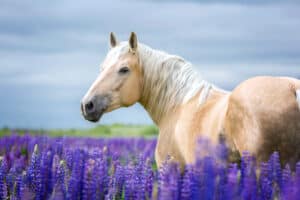A striking breed with American origins, the Appaloosa has long been valued for its intelligence, endurance, and beautiful spotted coats. The distinctive spotted coat is not unique to the Appaloosa breed and can appear in other breeds. However, most purebred Appaloosa horses have distinct characteristics that set them apart from other breeds. Discover what gives the Appaloosa a spotted coat, its fascinating origins, and more.
Origins of the Appaloosa
While evidence of spotted horses goes back centuries, the Appaloosa developed in the United States from Nez Perce breeding programs in the Pacific Northwest. This tribe bred horses descended from those brought to North America by the Spanish and traded to Native Americans in the 18th century.
However, the Appaloosa of the Nez Perce almost completely died out as a breed in 1876 due to the Nez Perce War. The U.S. military took control of the tribe’s herds, and only a few survived until the 1930s. At that point, several dedicated breeders, including Sam Fisher, stepped in to rescue the breed in eastern Oregon.
Today, the breed remains linked to Idaho, Oregon, and Washington. The Appaloosa Horse Club (ApHC), founded in 1938, has been instrumental in promoting the breed and preserving its integrity.
Why Are They Called Appaloosas?
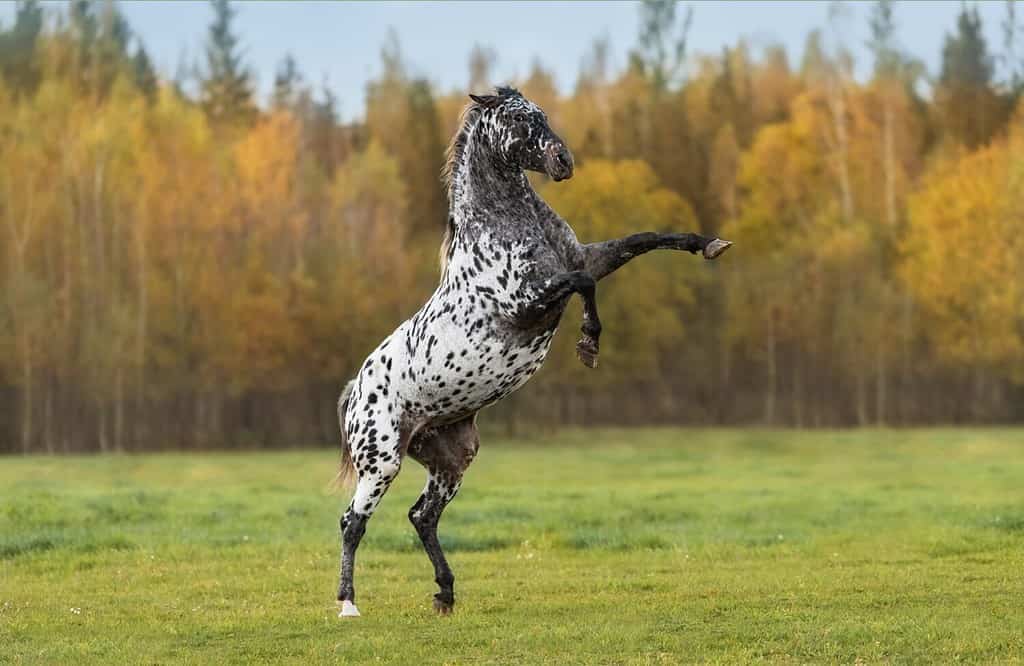
Lewis and Clark wrote about spotted horses among the Nez Perce tribe when their expedition came to the Palouse region of the Northwest Pacific.
©Rita_Kochmarjova/Shutterstock.com
The name comes from the original name of the Nez Perce’s spotted horses. Because the group lived near the Palouse River, the horses were called Palous horses or ‘a Palouse horse.’ Eventually, the name morphed into ‘Appaloosa’ for short.
Characteristics of the Appaloosa Horse
Mainly recognized for their spotted coats, Appaloosas are sometimes born without any pattern. These solid-colored Appaloosas can be verified via genetic testing and by looking at three main traits: white sclera, mottled skin, and striped hooves.
White Sclera
The area of the eye surrounding the iris, the sclera, is white in Appaloosa horses. For most other horse breeds, their sclera is dark.
Mottled Skin
Even if an Appaloosa has a solid coat color without a pattern, you can often still see mottled skin. The skin looks speckled, especially around the eyes, muzzle, and genitals.
Striped Hooves
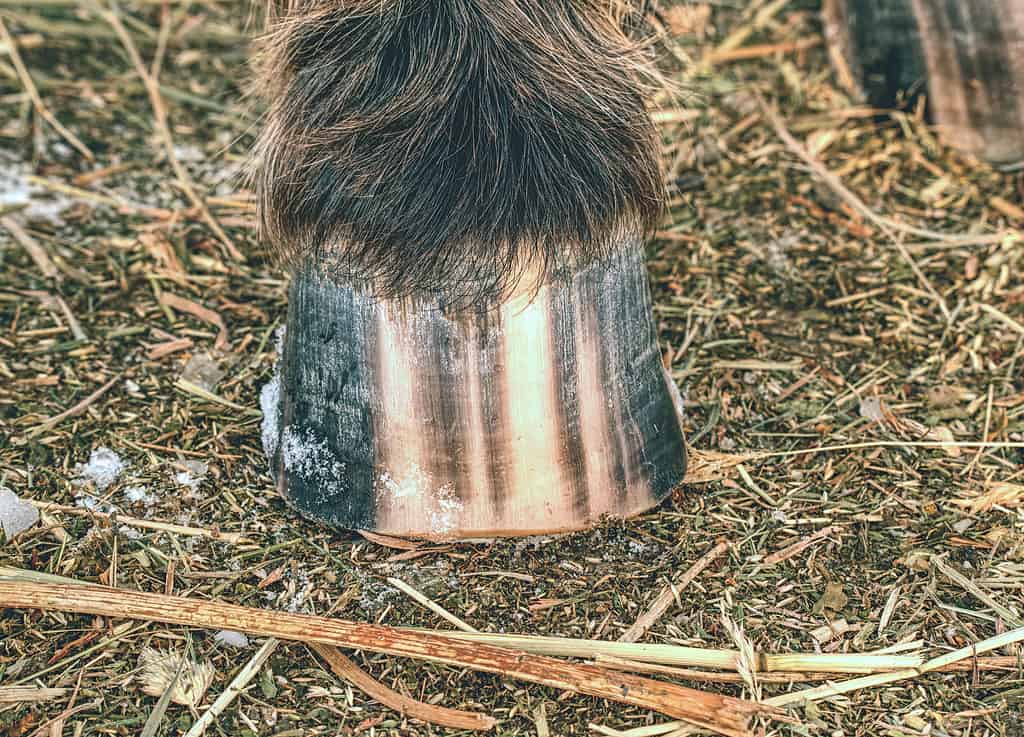
It is important to note that striped hooves can appear in other breeds, too. However, striped hooves are one of three main criteria for the Appaloosa breed.
©rdonar/iStock via Getty Images
Vertical striped hooves often are another indication of this breed. Most other horses will have all-white or all-black hooves. They might also have a mixture of solid-colored hooves. However, Appaloosas often have striped hooves that mix black and white on the same hoof.
Common Colors
The iconic look of an Appaloosa comes down to its dramatic spotted coat. However, spotted coats do not appear randomly. Specific genes determine the type and placement of spotting in horses. Appaloosas also appear in various colors, including black, chestnut, bay, and grey.
Leopard-Complex Gene
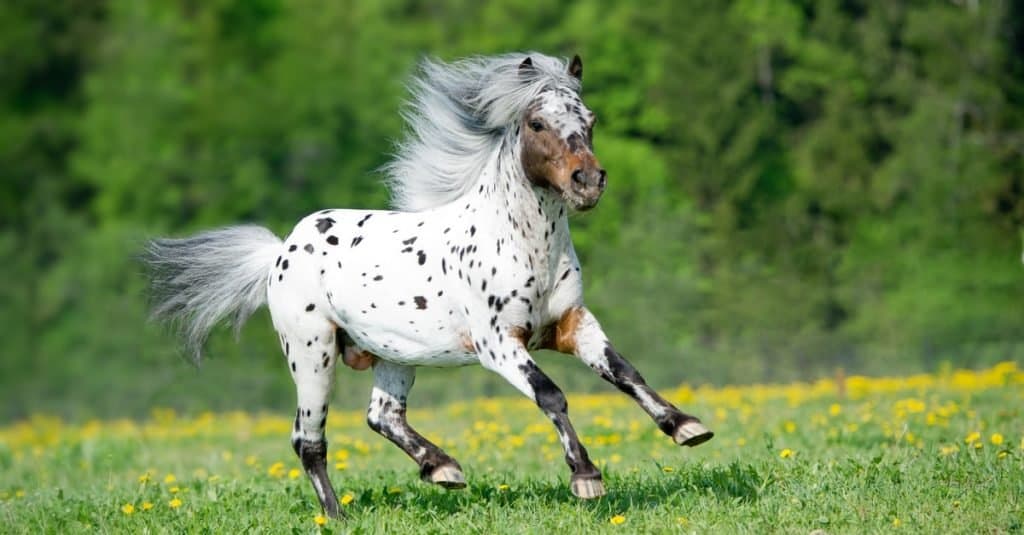
©olgaru79/Shutterstock.com
The most important gene in an Appaloosa, which determines whether it is part of the breed or not, is the leopard-complex gene. Other breeds, like the Knabstrupper, also carry this gene and display its unique spots.
One incomplete dominant gene (Lp) controls spotted coats in horses. Incomplete dominance means that the gene will be expressed differently depending on which copies are present in the animal. For example, horses with two dominant Lp genes do not have leopard traits and will not pass on leopard traits to offspring. Additionally, horses with two recessive lp genes (lp/lp) typically have smaller and fewer spots than horses with one dominant and one recessive gene (Lp/lp) with larger and more plentiful spotting.
Evidence exists that the leopard-complex gene produced prehistoric wild horses with spotted coats. The presence of the gene and spotting in breeds beyond the Appaloosa support these findings.
Recognized Appaloosa Patterns
- Spots – This pattern indicates either white or dark spots. Spotted horses might have spots over all or only a portion of their body.
- Snowflake – A dark-colored Appaloosa with white flecks is termed a snowflake. More flecks tend to appear and grow bigger with age.
- Blanket- Horses with a solid white area on the hip area have a blanket. Sometimes called a snowcap, this pattern might extend beyond the hips.
- Leopard – A white horse with dark spots across the entire body is called a leopard. Variations on this striking pattern include ‘few spot leopards’ and mottled.
- Few Spot Leopard – Mostly white with some color around the neck, head, and flank.
- Mottled – Sometimes, Appaloosas appear all-white; the only indication of a leopard complex is their mottled skin.
- Blanket with Spots – Appaloosas can also have a blanket pattern with spots on the white blanket.
- Appaloosa Roan – Also known as marble or varnish roan, this variation on the leopard pattern features intermixed light and dark hair. Lighter hair typically appears on the head and front of the face and over the back, loins, and hips. Dark hair appears on bony areas to create distinct ‘varnish marks.’
- Roan Blanket – Similar to a roan, a roan blanket pattern limits the mixture of dark and light hairs to the area around the hips. The blanket, however, can extend beyond the hips.
- Solid – A horse with no contrasting coat pattern might be registered as solid. Usually, a solid Appaloosa must also have visible mottled skin and at least one other characteristic.
Height and Weight
According to the Appaloosa Museum, height varies between 14 to 16 hands. The weight of an average adult horse comes in between 950 and 1,250 pounds. The Appaloosa Horse Club does not permit pony and draft breeding. This breed has been influenced by many different breeds, including American Quarter Horse, Thoroughbred, and Arabian, creating this wide range of body types.
Temperament
The intelligence of an Appaloosa is one thing that draws many people to this breed because they can readily adapt to different riding disciplines and tasks. Along with being intelligent and ready to learn new things, Appaloosas are associated with being very gentle and loyal horses. These aspects of their temperament work in tandem to create a versatile breed that loves to please its owner.
Common Uses
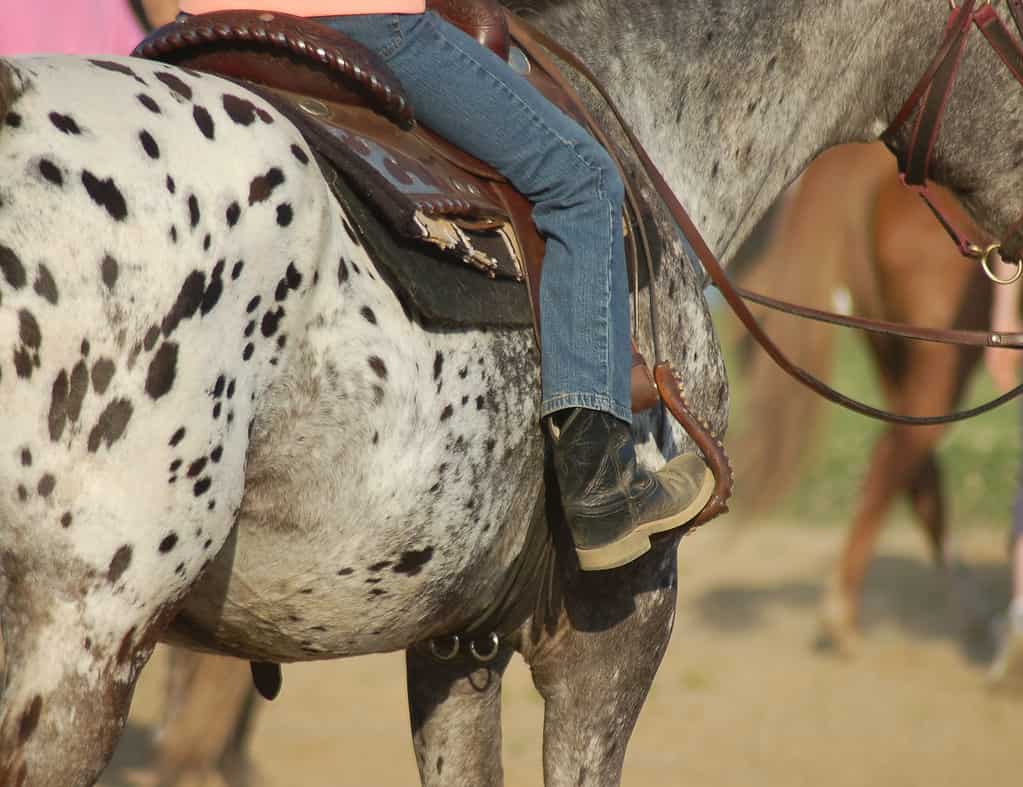
Appaloosas make great horses for endurance and trail riding. Its gentle and loyal nature also makes it a great horse for families and children.
©© MelissaAnneGalleries/iStock via Getty Images
A versatile horse breed, the Appaloosa features prominently in various disciplines, from dressage to roping. People compete with these horses in English and Western riding events, from show jumping to pole bending. Pole bending, called the Nez Perce Stake Race in Appaloosa horse shows, involves riders guiding their mounts through a weaving path of poles organized in a straight line.
Common Health Concerns
Some breeds of horses have predispositions for certain genetic issues, and Appaloosas are one of them. Compared to other breeds, they have an increased risk of developing equine recurrent uveitis (ERU), a type of acute inflammation of the eyes. Appaloosas are likelier to experience moon blindness issues and go blind in both eyes.
This breed may also have congenital stationary night blindness, often inherited by foals with two leopard-complex genes. Genetic testing can tell an owner if they should be concerned about this condition, which makes it impossible for an affected horse to see around dusk to dawn.
Diet and Nutrition
Like most other breeds, Appaloosa horses require adequate nutrition and a healthy, well-rounded diet to maintain optimal condition. Appaloosas require grass or hay daily, as well as supplemental grain.
Costs Associated With Owning An Appaloosa
Typical costs of owning an Appaloosa include the purchase price, boarding, and food. You should also allow for extensive veterinary and farrier care costs, especially if your Appaloosa inherits any genetic eye conditions.
Other Horse Breeds With Spotted Coats:
- Nez Perce Horse
- Knabstruppers
- Pony of the Americas
- Norikers
- Colorado Rangers
- Tiger Horses
Nez Perce Horse
The Appaloosa breed has a special connection to the Nez Perce Horse breed. In the 1990s, a breeding project begun by the Nez Perce Tribe of Idaho started crossing Appaloosa horses from the Wallowa herd and an old Central Asian breed, the Akhal-Teke. The goal was to recreate the tradition of selective breeding and reproduce horses similar to the original horses confiscated by the United States government after the Nez Perce War.
Fun Facts About Appaloosas
- Appaloosa can describe both the breed and color of a horse.
- They have been the official state horse of Idaho since 1975.
- Since the Appaloosa Horse Club was founded in 1938, over 700,000 horses have been officially registered.
- Coat patterns can change over time with age. For example, snowflake Appaloosas may develop more abundant and larger flecks of white.
The photo featured at the top of this post is © Anara55/iStock via Getty Images
Thank you for reading! Have some feedback for us? Contact the AZ Animals editorial team.





